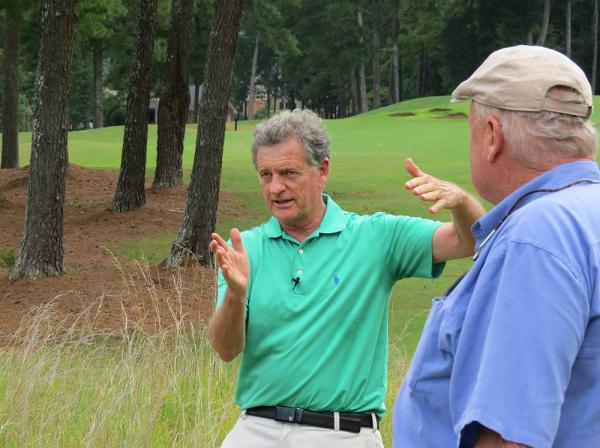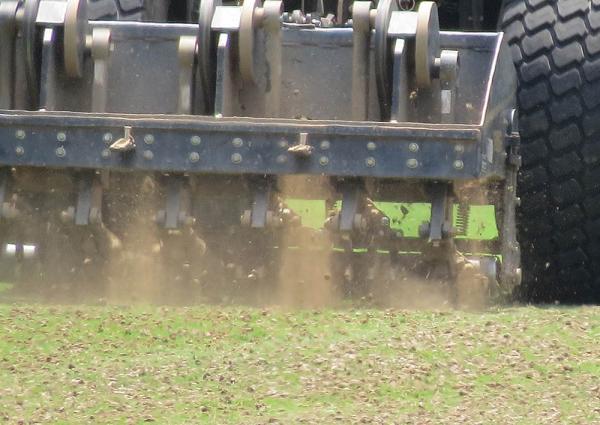Worms, compost fertilizer, biological soil amendments and Mark Hoban.
 A couple of decades ago, only one of these things could be found on golf courses around Georgia. Today, Hoban isn't the only superintendent using organic products and biologicals as part of their daily golf course maintenance routine.
A couple of decades ago, only one of these things could be found on golf courses around Georgia. Today, Hoban isn't the only superintendent using organic products and biologicals as part of their daily golf course maintenance routine.According to a report by PACE Turf, the use of non-pesticide options has been on the rise in recent years. When compared with a 2007 industry survey on pest management practices on U.S. golf courses, a follow-up study conducted in 2015 revealed that cultural practices are up by 66 percent, use of plant growth regulators has increased by 44 percent and use of biological products is up 25 percent. We were curious about the shift, so we asked a few people on why management practices are changing, and everyone we spoke with said they use natural products and employ cultural practices to augment, not replace, their chemical programs.
Hoban has fashioned a career centered around using organic products at Rivermont Golf Club in Johns Creek, Georgia. He makes his own worm compost, brews his own compost tea and even uses carbon-enhanced topdressing sand to introduce beneficial microbes into the soil.
"I slowly became more and more aware of the soil biology . . . . Compost and compost tea were the turning point in my program five years ago," Hoban said. "We were very successful the first year way beyond what I could have believed possible and the next year was as well."
While environmental stewardship and sustainability goals have influenced this trend toward increasing reliance on naturally occurring products, economics have played a role, as well.
"Economically, we're forced to reevaluate everything we're doing," said Fred Gehrisch, CGCS at Highlands Falls Country Club in Highlands, North Carolina. "The easy thing to do is put out pesticides and be preventive about everything. But that is expensive, and golf isn't what it used to be."
Among the changes at Highlands Falls is the use of Holganix, a blend of beneficial microorganisms. Gehrisch said he was willing to give it a try, but would not hesitate to scrap it if there were no signs of healthier turf.
"The first year, I saw an improvement of about 10 percent, which is big for us, because we're already maintaining turf at a high level," Gehrisch said.
"For us, it has to be economically feasible. It has to provide an improvement to what we're doing. It has to reduce disease. With Holganix, we saw all of that. I wasn't expecting that."
During his career, Matt Shaffer has become notorious for his increasingly minimalist approach to managing turf at Merion Golf Club, where he says his goal is to grow grass, not spray it or water it. He teaches those who work for him to do the same.
 "I love to mentor young people, and I am thoroughly convinced that some day they are not going to have as much chemistry as we do now," Shaffer said. "Consequently, several years ago I started a program growing great grass with less chemistry. The really cool thing is that the young guys believe and live it. We utilize less water and grow healthy turf and work harder at not spraying (rather) than always spraying."
"I love to mentor young people, and I am thoroughly convinced that some day they are not going to have as much chemistry as we do now," Shaffer said. "Consequently, several years ago I started a program growing great grass with less chemistry. The really cool thing is that the young guys believe and live it. We utilize less water and grow healthy turf and work harder at not spraying (rather) than always spraying."Incorporating cultural programs also is on the rise thanks to some of the research being conducted at universities nationwide.
During a recent TurfNet Webinar, Thom Nikolai, Ph.D., of Michigan State said rolling research conducted by Bayer's Paul Giordano, Ph.D., when he was a Master's student at MSU, produced an unintended consequences - increased dollar spot resistance. Studies showed that plots rolled twice daily showed less dollar spot than control plots as well as plots rolled once per day.
Other cultural practices, said Jim Pavonetti, CGCS at Fairview Country Club in Greenwich, Connecticut, can help provide a natural path to improved plant health.
"Maintaining good aeration, regular topdressing, good fertility, wetting agent programs, plant growth regulators and pinpoint irrigation practices were all things that we weren't mastering 10 to 15 years ago," Pavonetti said. "Once all of these programs were in place, diseases like basal rot anthracnose became very easy to prevent, where, in the late '90s and early 2000s, it seemed like nothing would control the disease once the environmental factors would become too intense. The increased use of plant growth regulators has enabled us to increase fertility and plant health without losing the quality playing surfaces by regulating the natural flush of growth that would occur otherwise."
The trend toward incorporating more natural products and cultural practices, however, is seen as a supplement or occasional alternative to a program that includes synthetic products, not a replacement. The PACE report also reveals that use of fungicides over the past decade is up 4 percent and herbicide use has rise 2 percent. After all, there is a reason only one course - Vineyard Golf Club on Martha's Vineyard - is billed as the country's only true organic golf course.
Supplementing his program with biologicals has allowed Gehrisch to extend the period between fungicide apps, not replace them. But when it comes to eliminating insect pests, nothing beats a chemical insecticide.
"For insects, I don't see anything that I'm willing to bet my career on," Gehrisch said. "There is not a biological or holistic product out there that anyone is willing to bet their life on. While some of those products work, they all work some of the time."

